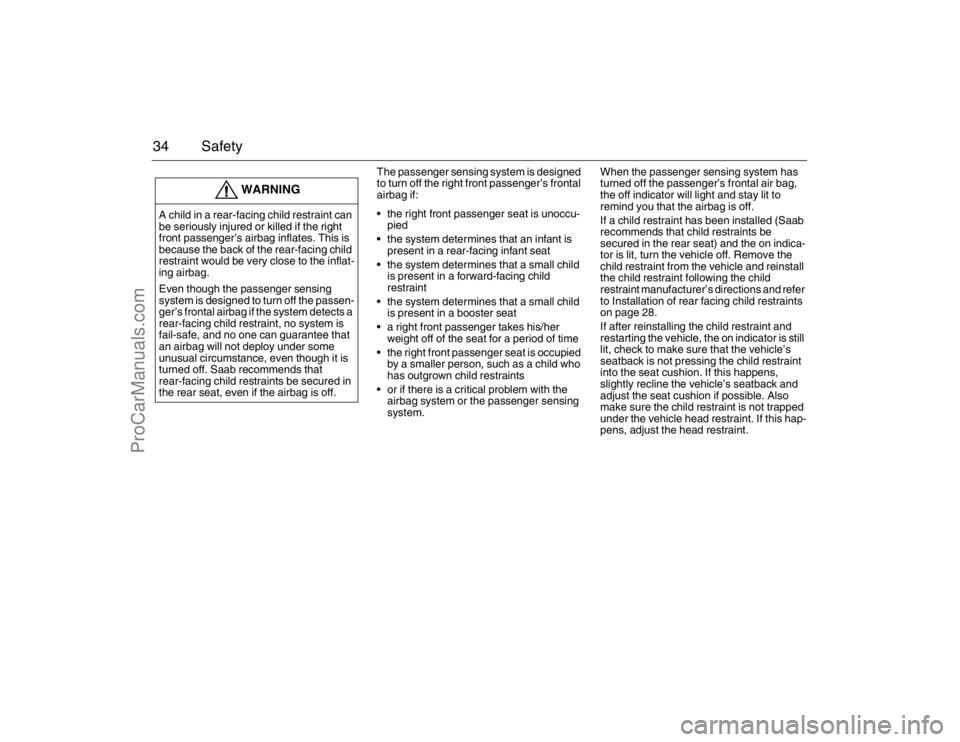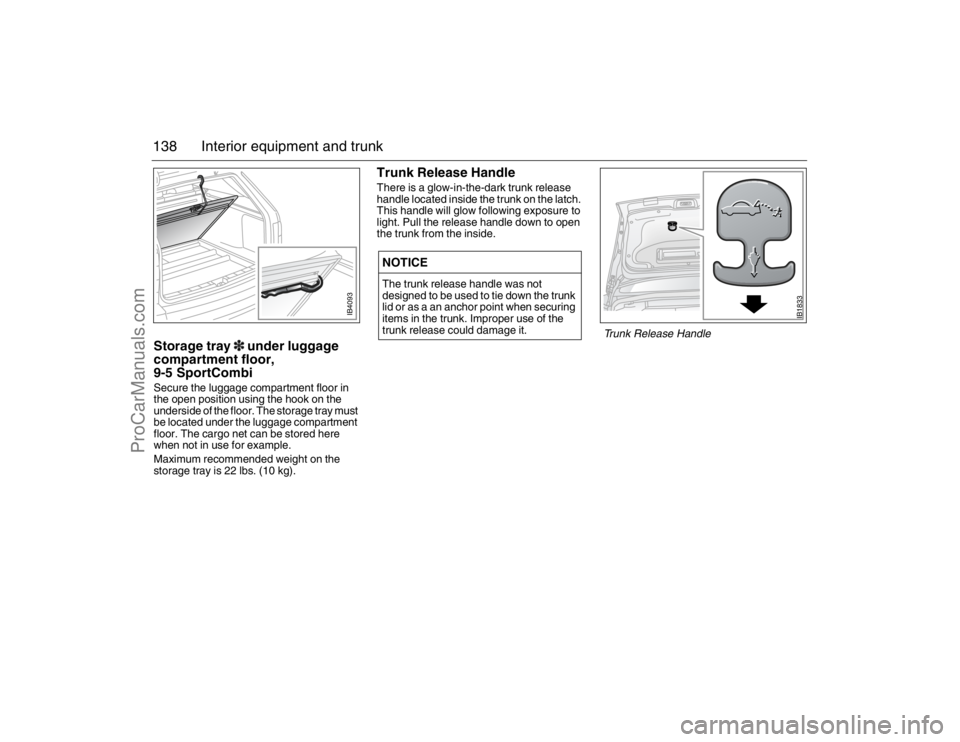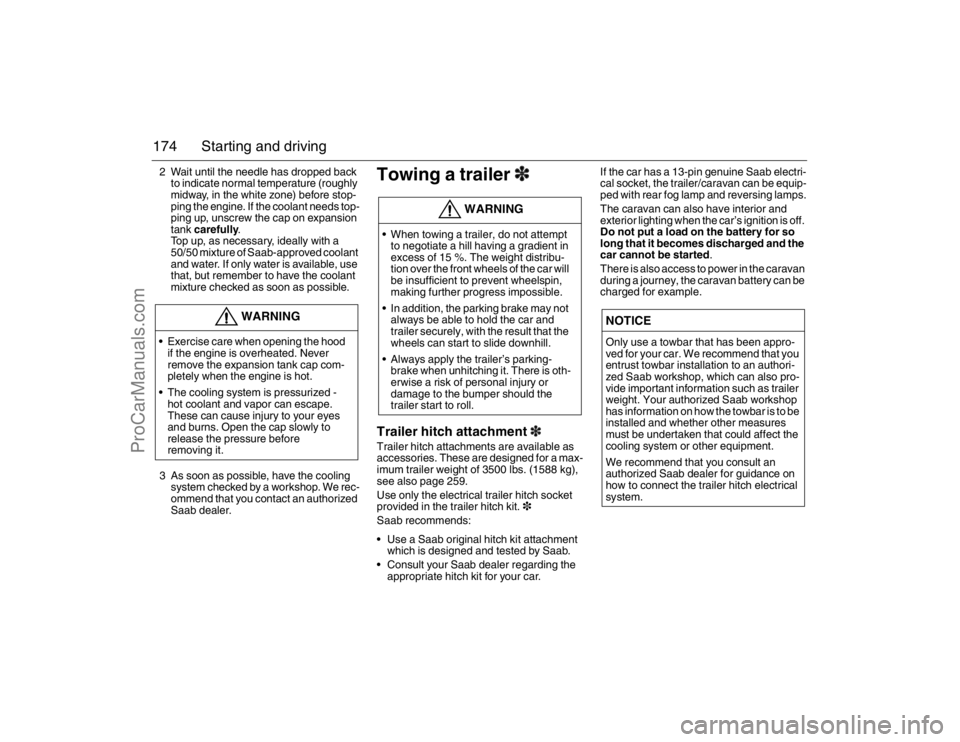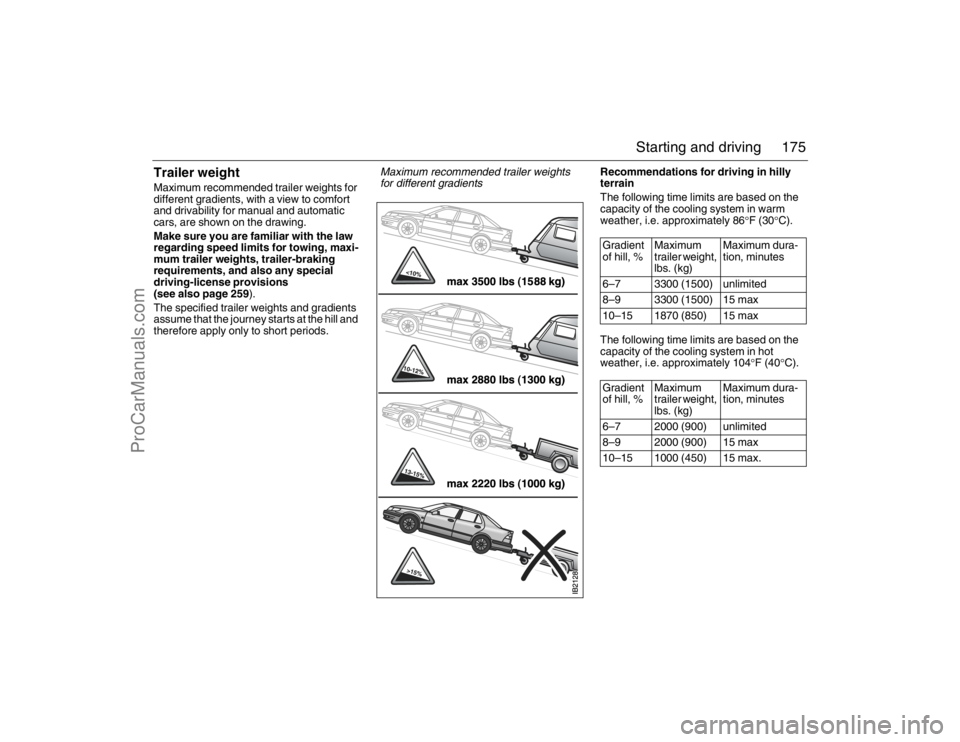weight SAAB 9-5 2007 Owners Manual
[x] Cancel search | Manufacturer: SAAB, Model Year: 2007, Model line: 9-5, Model: SAAB 9-5 2007Pages: 288, PDF Size: 18.14 MB
Page 21 of 288

21 Safety
Head restraintThe front seats in the Saab 9-5 are
equipped with Saab Active Head Restraints
(SAHRs). These reduce the risk of whiplash
injury if the car is hit from behind.
In the event of a rear-end crash, the body is
forced back against the backrest. This, in
turn, causes the mechanism to press the
head restraint forward and upward, thus lim-
iting the backward movement of the head.
The SAHR is a mechanical system, actu-
ated by body weight. The mechanism is built
into the top of the backrest, where it is con-
nected to the head restraint.
Therefore, the SAHR does not need to be
replaced after a minor rear-end crash.The head restraint can be raised or lowered
and is adjustable in various positions.
Raising: grasp the head restraint on both
sides and pull it straight up.
Lowering: press the catch on the left-hand
side of the attaching point and press down
the head restraint.
Rear-seat head restraints9-5 Sedan: The rear head restraints have
three adjustment positions for passenger
comfort.
They can also be folded down to increase
the driver’s rearward vision when the seat is
unoccupied.
9-5 SportCombi: The height of the rear
head restraints can be adjusted by depress-
ing the catch on the left-hand collar in the
same way as the front head restraints.
WARNING
Adjust the head restraint so that your
head is optimally supported and the
center of the head restraint is at ear
height, thus reducing the likelihood of
neck injury in a crash.
Raise the head restraints in the seat
that are occupied.
IB400
IB460
95_U S _M 07.book Page 21 Friday, June 9, 2006 8:58 AM
ProCarManuals.com
Page 34 of 288

34 Safety
The passenger sensing system is designed
to turn off the right front passenger’s frontal
airbag if:
the right front passenger seat is unoccu-
pied
the system determines that an infant is
present in a rear-facing infant seat
the system determines that a small child
is present in a forward-facing child
restraint
the system determines that a small child
is present in a booster seat
a right front passenger takes his/her
weight off of the seat for a period of time
the right front passenger seat is occupied
by a smaller person, such as a child who
has outgrown child restraints
or if there is a critical problem with the
airbag system or the passenger sensing
system.When the passenger sensing system has
turned off the passenger’s frontal air bag,
the off indicator will light and stay lit to
remind you that the airbag is off.
If a child restraint has been installed (Saab
recommends that child restraints be
secured in the rear seat) and the on indica-
tor is lit, turn the vehicle off. Remove the
child restraint from the vehicle and reinstall
the child restraint following the child
restraint manufacturer’s directions and refer
to Installation of rear facing child restraints
on page 28.
If after reinstalling the child restraint and
restarting the vehicle, the on indicator is still
lit, check to make sure that the vehicle’s
seatback is not pressing the child restraint
into the seat cushion. If this happens,
slightly recline the vehicle’s seatback and
adjust the seat cushion if possible. Also
make sure the child restraint is not trapped
under the vehicle head restraint. If this hap-
pens, adjust the head restraint.
WARNING
A child in a rear-facing child restraint can
be seriously injured or killed if the right
front passenger’s airbag inflates. This is
because the back of the rear-facing child
restraint would be very close to the inflat-
ing airbag.
Even though the passenger sensing
system is designed to turn off the passen-
ger’s frontal airbag if the system detects a
rear-facing child restraint, no system is
fail-safe, and no one can guarantee that
an airbag will not deploy under some
unusual circumstance, even though it is
turned off. Saab recommends that
rear-facing child restraints be secured in
the rear seat, even if the airbag is off.95_U S _M 07.book Page 34 Friday, June 9, 2006 8:58 AM
ProCarManuals.com
Page 135 of 288

135 Interior equipment and trunk
Load anchoring
Driving with the trunk lid/tailgate open,
see page 183.
WARNING
Put heavy loads as low down and as
far forward as possible in the luggage
compartment, i.e. against the back of
the rear seat.
Never overload the cargo net3. If the
elastic breaks this may cause personal
injury. Do not use a cargo net that
shows signs of wear.
Never stack cargo so high that any part
of the cargo lies above the edge of the
backrest, if a cargo guard3 is not
being used.
Always tie down the cargo so that it
cannot be thrown forward during
heavy braking or in the event of a
crash.
Unsecured and heavy cargo can
increase the risk of injury during hard
braking, sudden avoidance maneu-
vers and in the event of a crash.
For the best load anchoring, use the
special cargo tie down eye and load
straps3.
Load the cargo tie down eyes evenly.
Never attach more than one strap to
each tie down eye.
Provide protection on sharp edges to
prevent damage to the load straps.
Never use the elastic floor net3 and
elastic side net (accessory) when the
rear seat is folded down. These nets
are only intended to keep light objects
tidy, not for the anchoring of loads.
If possible, avoid having the rear seat
folded down when driving with a heavy
load because the anchoring possibili-
ties are restricted when the rear seat is
in this position. That the rear seat is
in the upright position is a basic
requirement for protection against
cargo displacement in the event of
a crash.
Cargo can intrude into the passenger
compartment during a sudden stop or
front crash if the outer safety belts are
not fastened. Check that the two red
warning-indication flags are fully
down. This shows that the backrests
are locked.
WARNING
Match the speed and driving style
according to how the car is loaded.
The driving characteristics of the car
can be affected because the center of
gravity is altered when there is a cargo
in the luggage compartment.
An object weighing 55 lbs. (25 kg) cor-
responds to a weight of 2200 lbs.
(1000 kg) in a head on crash at
32 mph (50 km/h).
Adjust the car’s load (passengers and
luggage) so that the gross vehicle
weight or the axle weight is not
exceeded, see page 258.
95_U S _M 07.book Page 135 Friday, June 9, 2006 8:58 AM
ProCarManuals.com
Page 138 of 288

138 Interior equipment and trunkStorage tray 3 under luggage
compartment floor,
9-5 SportCombiSecure the luggage compartment floor in
the open position using the hook on the
underside of the floor. The storage tray must
be located under the luggage compartment
floor. The cargo net can be stored here
when not in use for example.
Maximum recommended weight on the
storage tray is 22 lbs. (10 kg).
Trunk Release HandleThere is a glow-in-the-dark trunk release
handle located inside the trunk on the latch.
This handle will glow following exposure to
light. Pull the release handle down to open
the trunk from the inside.NOTICEThe trunk release handle was not
designed to be used to tie down the trunk
lid or as a an anchor point when securing
items in the trunk. Improper use of the
trunk release could damage it.
IB1833
Trunk Release Handle
IB4093
95_U S _M 07.book Page 138 Friday, June 9, 2006 8:58 AM
ProCarManuals.com
Page 174 of 288

174 Starting and driving2 Wait until the needle has dropped back
to indicate normal temperature (roughly
midway, in the white zone) before stop-
ping the engine. If the coolant needs top-
ping up, unscrew the cap on expansion
tank carefully.
Top up, as necessary, ideally with a
50/50 mixture of Saab-approved coolant
and water. If only water is available, use
that, but remember to have the coolant
mixture checked as soon as possible. 3 As soon as possible, have the cooling
system checked by a workshop. We rec-
ommend that you contact an authorized
Saab dealer.
Towing a trailer3Trailer hitch attachment3Trailer hitch attachments are available as
accessories. These are designed for a max-
imum trailer weight of 3500 lbs. (1588 kg),
see also page 259.
Use only the electrical trailer hitch socket
provided in the trailer hitch kit.3
Saab recommends:
Use a Saab original hitch kit attachment
which is designed and tested by Saab.
Consult your Saab dealer regarding the
appropriate hitch kit for your car.If the car has a 13-pin genuine Saab electri-
cal socket, the trailer/caravan can be equip-
ped with rear fog lamp and reversing lamps.
The caravan can also have interior and
exterior lighting when the car’s ignition is off.
Do not put a load on the battery for so
long that it becomes discharged and the
car cannot be started.
There is also access to power in the caravan
during a journey, the caravan battery can be
charged for example.
WARNING
Exercise care when opening the hood
if the engine is overheated. Never
remove the expansion tank cap com-
pletely when the engine is hot.
The cooling system is pressurized -
hot coolant and vapor can escape.
These can cause injury to your eyes
and burns. Open the cap slowly to
release the pressure before
removing it.
WARNING
When towing a trailer, do not attempt
to negotiate a hill having a gradient in
excess of 15 %. The weight distribu-
tion over the front wheels of the car will
be insufficient to prevent wheelspin,
making further progress impossible.
In addition, the parking brake may not
always be able to hold the car and
trailer securely, with the result that the
wheels can start to slide downhill.
Always apply the trailer’s parking-
brake when unhitching it. There is oth-
erwise a risk of personal injury or
damage to the bumper should the
trailer start to roll.
NOTICEOnly use a towbar that has been appro-
ved for your car. We recommend that you
entrust towbar installation to an authori-
zed Saab workshop, which can also pro-
vide important information such as trailer
weight. Your authorized Saab workshop
has information on how the towbar is to be
installed and whether other measures
must be undertaken that could affect the
cooling system or other equipment.
We recommend that you consult an
authorized Saab dealer for guidance on
how to connect the trailer hitch electrical
system.
95_U S _M 07.book Page 174 Friday, June 9, 2006 8:58 AM
ProCarManuals.com
Page 175 of 288

175 Starting and driving
Trailer weightMaximum recommended trailer weights for
different gradients, with a view to comfort
and drivability for manual and automatic
cars, are shown on the drawing.
Make sure you are familiar with the law
regarding speed limits for towing, maxi-
mum trailer weights, trailer-braking
requirements, and also any special
driving-license provisions
(see also page 259).
The specified trailer weights and gradients
assume that the journey starts at the hill and
therefore apply only to short periods. Recommendations for driving in hilly
terrain
The following time limits are based on the
capacity of the cooling system in warm
weather, i.e. approximately 86°F (30°C).
The following time limits are based on the
capacity of the cooling system in hot
weather, i.e. approximately 104°F (40°C).
Gradient
of hill, % Maximum
trailer weight,
lbs. (kg)Maximum dura-
tion, minutes
6–7 3300 (1500) unlimited
8–9 3300 (1500) 15 max
10–15 1870 (850) 15 max
Gradient
of hill, % Maximum
trailer weight,
lbs. (kg)Maximum dura-
tion, minutes
6–7 2000 (900) unlimited
8–9 2000 (900) 15 max
10–15 1000 (450) 15 max.
Maximum recommended trailer weights
for different gradients
95_U S _M 07.book Page 175 Friday, June 9, 2006 8:58 AM
ProCarManuals.com
Page 178 of 288

178 Starting and drivingTrailer hitch loadThe weight distribution on the trailer makes
a lot of difference to the handling properties
of the car and trailer combination. As
regards single-axle trailers, whenever pos-
sible, concentrate the load over the wheels
and keep it as low as possible.
The trailer should be loaded so that the
maximum load on the towbar ball is 5 % to
7 % of the trailer weight with a maximum
permissible tongue weight of 110–165 lbs.
(50–75 kg).
Note that this load must be added to the total
load for the car. If this now exceeds the
specified load capacity, the load in the lug-
gage compartment will have to be reduced
by a corresponding amount.
WARNING
When you connect the trailer be sure to
attach its safety chains to the holes as
illustrated.
IB106
Distribution of load in trailer aLight
b Moderate
cHeavy
Attach the safety chains to the holes as
illustrated
95_U S _M 07.book Page 178 Friday, June 9, 2006 8:58 AM
ProCarManuals.com
Page 181 of 288

181 Starting and driving
Driving at nightBear in mind the following points when
driving at night:
Nighttime driving requires your full con-
centration.
Do not rush. Count on your journey taking
slightly longer.
The number of drivers under the influence
of drugs is likely to be greater at night than
during the day.
Do not stare at the headlights of oncom-
ing vehicles.
Avoid driving at night if you have poor
eyesight. Night vision deteriorates with
age.
Keep your car's headlights, windows and
mirrors clean. Also, if you wear glasses,
make sure they are clean.
Make sure you are well rested before
starting a long journey. Take a break
every other hour.
Only eat light meals. Heavy meals have a
tendency to induce tiredness.
Driving with a loadThe driving characteristics of the car are
affected by the way it is loaded.
Place heavy loads as far forward and as
low as possible in the trunk.
Secure the load to the tie downs, see
page 131.
The load should be such that the car´s
total weight or axle weight are not
exceeded, see page 258.
Heavy loads mean that the car’s center of
gravity is further back. As a result, the car
will sway more during evasive steering.
Never exceed the permissible load in the
roof box3, even if there is room for more.
Ensure that the tire pressure is correct –
slight overinflation is preferable to under-
inflation.
The braking distance of a loaded car is
always greater. Keep your distance from
the vehicle in front.
Roof loads can negatively affect tele-
communication.
Tire pressure, see page 268 and back
cover.
95_U S _M 07.book Page 181 Friday, June 9, 2006 8:58 AM
ProCarManuals.com
Page 231 of 288

231 Car care and technical information
Loading Your VehicleThis is an example of what your vehicle´s
Tire-Loading Information/Certification label
might look like. It is located on the B-pillar
and shows how much weight your vehicle
may properly carry. The label tells you the
proper size, and recommended inflation
pressures for the tires on your vehicle. It
also gives you important information about
the number of people that can be in your
vehicle and the total weight that you can
carry. This weight is called the Vehicle
Capacity Weight, and includes the weight of
all occupants, cargo and all nonfac-
tory-installed options.
Tire Terminology and DefinitionsAir Pressure: The amount of air inside the
tire pressing outward on each square inch of
the tire. Air pressure is expressed in pounds
per square inch (psi) or kilopascal (kPa).
Accessory Weight: This means the com-
bined weight of optional accessories, for
example, automatic transmission, power
steering, power brakes, power windows,
power seats, radio and air conditioning.
Aspect Ratio: The relationship of a tire´s
height to its width.
Belt: A rubber coated layer of cords that is
located between the plies and the tread.
Cords may be made from steel or other rein-
forcing materials.
Bias Ply Tire: A pneumatic tire in which the
ply cords that extend to the beads are laid at
alternate angles substantially less than 90
degrees to the centerline of the tread.
Cold Inflation Pressure: The amount of air
pressure in a tire, measured in pounds per
square inch (psi) or kilopascal (kPa), before
a tire have built up heat from driving. See
“Inflation - Tire Pressure” on page 222.
Curb weight: This means the weight of a
motor vehicle with standard and optional
equipment including the maximum capacity
of fuel, oil and coolant, without passengers
and cargo.DOT Markings: A code molded into the
sidewall of a tire signifying that the tire is in
compliance with the U.S. Department of
Transportation motor vehicle safety stan-
dards. The DOT code includes the Tire
Identification Number (TIN), an alphanu-
meric designator which can also identify the
tire manufacturer, production plant, brand
and date of production.
GVWR: Gross Vehicle Weight Rating see
“Loading Your Vehicle” on page 231.
GAWR FRT: Gross Axle Weight Rating for
the front axle, see “Loading Your Vehicle”
on page 231.
GAWR RR: Gross Axle Weight Rating for
the rear axle, see “Loading Your Vehicle” on
page 231.
Intended Outboard Sidewall: The side of
an asymmetrical tire that must always face
outward when mounted on a vehicle.
Kilopascal (kPa): The metric unit for air
pressure. There are 6.9 kPa to one psi.
Light Truck (LT-Metric) Tire: A tire used
on light duty trucks and some multipurpose
passenger vehicles.
Load Index: An assigned number ranging
from 1 to 279 that corresponds to the load
carrying capacity of a tire.
This label can only be found on vehicles
sold in the U.S.
Vehicles sold in Canada have the tire
information label in the glovebox, see
page 268.
95_U S _M 07.book Page 231 Friday, June 9, 2006 8:58 AM
ProCarManuals.com
Page 232 of 288

232 Car care and technical informationMaximum Load rating: The load rating for
a tire at the maximum permissible inflation
pressure for that tire.
Maximum Loaded Vehicle Weight: The
sum of curb weight; accessory weight; vehi-
cle capacity weight; and production options
weight.
Maximum Permissible Inflation Pres-
sure: The maximum cold inflation pressure
to which a tire may be inflated.
Normal occupant weight: The number of
occupants a vehicle is designed to seat mul-
tipled by 150 pounds (68 kg). See “Loading
Your Vehicle” on page 231.
Occupant Distribution: Designated seat-
ing positions.
Outward Facing Sidewall: The side of a
asymmetrical tire that has a particular side
that faces outward when mounted on a vehi-
cle. The side of the tire that contains a white-
wall bears white lettering or bears manufac-
turer, brand and or model name molding on
the other sidewall of the tire.
Passenger (P-Metric) Tire: A tire used on
passenger cars and some light duty trucks
and multipurpose vehicles.Recommended Inflation Pressure: Vehi-
cle manufacturer´s recommended tire infla-
tion pressure shown on the tire label, see
“Inflation - Tire Pressure” on page 222 and
“Loading Your Vehicle” on page 231.
Radial Ply Tire: A pneumatic tire in which
the ply cords that extend to the beads are
laid at substantially 90 degrees to the cen-
terline of the tread.
Rim: A metal support for a tire or a tire and
tube assembly upon which the tire beads
are seated.
Sidewall: The portion of a tire between the
tread and the bead.
Speed rating: An alphanumeric code
assigned to a tire indicating the maximum
speed at which a tire can operate.
Traction: The friction between the tire and
the road surface. The amount of grip pro-
vided.
Treadwear Indicators: Narrow bands,
sometimes called “wear bars”, that show
across the tread of a tire when only
2/32 inch of tread remains. See “When It Is
Time for New Tires” on page 224.Tread Width: The width of the tire´s tread.
UTQGS: Uniform Tire Quality Grade Stan-
dards, a tire information system that pro-
vides consumers with ratings for a tire´s
traction, temperature and treadwear. Rat-
ings are determined by tire manufacturers
using government testing procedures. The
rating are molded into the sidewall of the
tire. See “Uniform Tire Quality Grading” on
page 226.
Vehicle Capacity Weight: Is the number of
designated seating positions multipled by
150 pounds (68 kg) plus the rated cargo
load. See “Loading Your Vehicle” on
page 231.
Vehicle Maximum Load on the Tire: Load
on an individual tire due to curb weight,
accessory weight, occupant weight and
cargo weight.
Vehicle label: A label permanently
attached to a vehicle showing original
equipment tire size and the recommended
cold inflation pressure. See “Loading Your
Vehicle” on page 231.95_U S _M 07.book Page 232 Friday, June 9, 2006 8:58 AM
ProCarManuals.com